A root cellar is a storage space built underground to preserve perishable items like fruits, vegetables, and other root crops for an extended time.
The root cellar’s environment provides a cool, dark, and humid environment that helps slow the natural decay process and keeps produce fresh during hot climates or winter months.
Traditionally, root cellars had been used in rural areas where people relied on homegrown food and needed a way to store their harvests longer without refrigeration.
However, they can still be functional for homeowners interested in preserving food without relying solely on modern technology.
In fact, a root cellar is a perfect storage solution in an off-grid situation where underground space might be limited.
Because constructing a traditional underground root cellar may not be feasible, you can still adapt the concept of a root cellar to build a simple root cellar in a box and work within the constraints of a grid environment.
What Can You Store In A Root Cellar?
Not all fruits and vegetables store well in root cellars. However, hardy fruits and a few root veggies can survive the root cellar’s environment.
Here are fifteen fruits and veggies that do well in a root cellar: apples, beets, brussels sprouts, cabbages, carrots, garlic, leeks, onions, parsnips, pears, potatoes, pumpkin, squash, sweet potatoes, and turnips.
Construction
Constructing a root cellar in a box can be a practical option if you have limited space or resources in your backyard.
But before construction begins, it’s essential to remember that the design you choose varies depending on the climate, available resources, and personal preferences.
Here’s a step-by-step guide:
Step 1: Gathering all the necessary supplies and materials
You will need a few materials for this construction. Luckily, a root cellar in a box requires a few materials.
You will need some sturdy wooden panels, two paving slabs, gravel (optional), and sawdust/straw.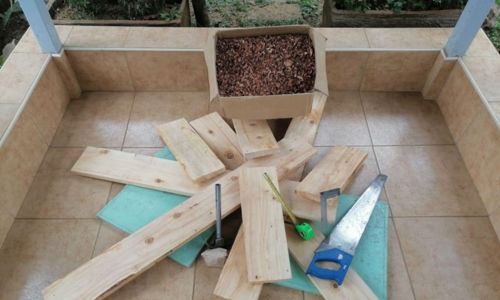
Step 2: Building the box
Always choose the precise box size to accommodate your desired produce when constructing. Consider using materials like wood or thick Styrofoam that provide good insulation.
Related: Root Cellar Mistakes You Need To Avoid At All Costs
In my case, I used termite treated 4 (feet) x 2 (feet) x 2 (feet) long wooden panels to construct the cellar’s frame. This size was enough to store a handful of root crops.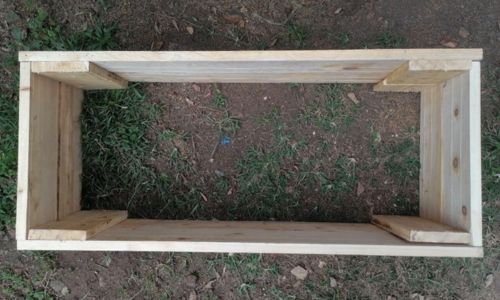
Note: You can still use long wood panels to build a larger box if you have enough space in your backyard.
I left the bottom open to allow adequate drainage and effective humidity control. Instead, I will place two paving slabs at the bottom to give the cellar a nice finish to discourage termites, moles, and other critters from accessing my produce.
Step 3: Ventilating the cellar
The next step will be drilling ventilation holes in the sides of the box to allow for airflow. These holes will also help regulate temperature and prevent excess moisture buildup inside the box.
But you’ll need to place the holes at the top (to allow warm air to escape the cellar) and the bottom section to allow cold air to enter.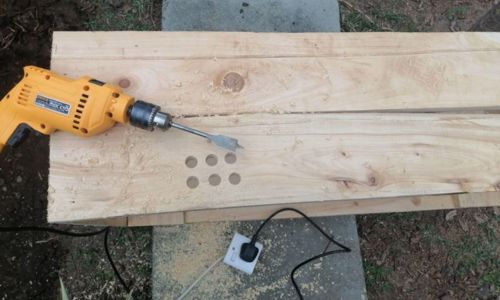
Step 4: Attaching the doors
I used some two old cabinet doors because they were still in perfect condition for the opening.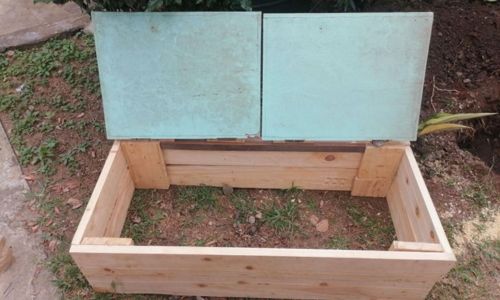
Step 5: Choosing a spot and digging the hole
Choose a well-drained spot and dig a hole about 1 foot larger than the box on all sides. But remember that the area chosen should not be near a tree because the roots of the tree might grow and crack the cellar.
You should also consider a deeper hole to store produce below the ground if winter temperatures drop below 25֯C.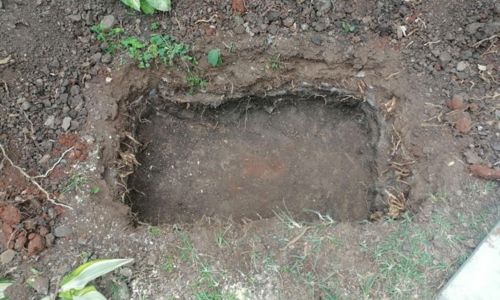
Step 6: Inserting paving slabs
I carefully inserted two paving slabs inside the hole to levelized the root cellar floor and to prevent moles and mites from accessing my produce.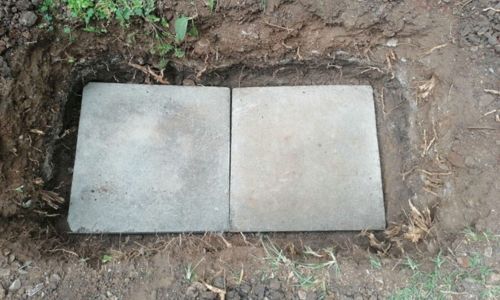
Step 7: Insulating the box
I used sawdust to line the walls and floor of the box. This insulation will help maintain a stable temperature inside the box. But you can use straws or foam panels, depending on what’s available at home.
Related: Straw-bale Bug Out House: How One Of Our Readers Did It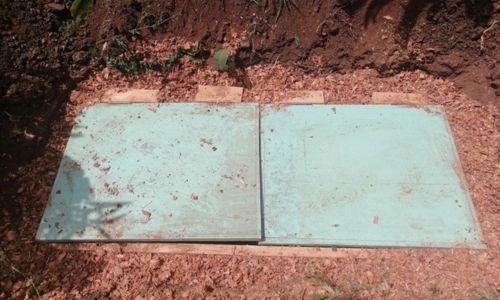
Note: I placed a layer of damp sawdust at the bottom to maintain the perfect humid environment.
Tips:
- You need to place a container of water inside the box to increase humidity levels. This will help prevent wilting and drying out of the stored produce.
- You can also add damp sand or sawdust to the bottom of the box to further enhance humidity control.
- Install shelves or racks inside the box to maximize storage space and organize it better. But use sturdy materials that can withstand the weight of the stored items.
Step 8: Storing Produce
Arrange your fruits and vegetables, making sure to leave some space between them for proper airflow.
I placed onions and carrots in the box and covered them with about an inch of sawdust, but you can use peat moss as an alternative solution.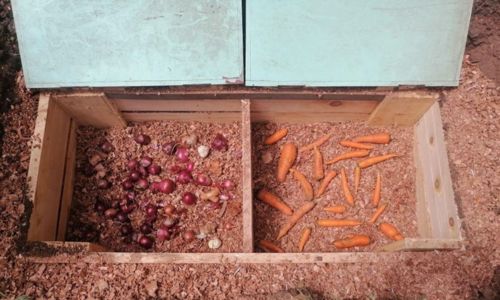
Afterward, I placed potatoes and cabbages and added a layer of sawdust.
Continue layering the roots with sawdust until you fill-up the box. This arrangement will help moisture distribution and minimize crop rotting.
Related: 10 Vegetables That You Can Stockpile Without Refrigeration For A Full Year
You should store items that require similar temperature and humidity conditions together.
Check the root cellar box regularly to ensure the temperature and humidity are within the desired range. You can adjust ventilation and insulation as needed.
Features And Considerations
Here are some key features and considerations for a root cellar:
- Location: Ideally, a root cellar should be partially underground or underground to maintain consistent temperature throughout the year.
- Ventilation: Proper ventilation is essential to regulate temperature and humidity inside the root cellar. You can achieve it through vents or pipes that allow fresh air to circulate while preventing excess moisture buildup.
- Insulation: Good insulation regulates the temperature inside the root cellar. To prevent heat transfer, you can use soil, straw bales, or insulation panels along the walls, ceiling, and floor.
- Humidity control: Fruits and vegetables require a humid environment to prevent wilting. So, you can maintain moisture in a root cellar by placing water containers, damp sand, or covering the floor with layers of moistened sand or sawdust.
- Shelving and storage: You can install adequate wooden slats, wire mesh shelving, and racks to store the produce to ensure proper airflow around the stored items and prevent mold/rot.
- Temperature regulation: The ideal temperature for a root cellar is typically between 32°F (0°C) and 50°F (10°C). To achieve this, use the natural coolness of the ground to bring in cooler air during hot seasons.
- Pest control: Use the correct approaches to prevent rodents, insects, and other pests from entering the root cellar. Seal openings or cracks and regularly inspect/clean the cellar.
A root cellar is an old-fashioned but effective technique for storing root crops at home. It is among the perfect solutions in a grid situation because of its simple eco-friendly design and natural preservation characteristics.
With this root cellar in a box design, you can preserve fruits and vegetables over the winter months.
You may also like:
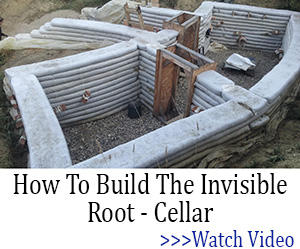 EMP Prevention Plan: Why Our Government Has Done Nothing
EMP Prevention Plan: Why Our Government Has Done Nothing
What To Do With All Your Frozen Food Once The Power Goes Out (Video)
6 Warning Signs Before An Economic Collapse That Most People Miss

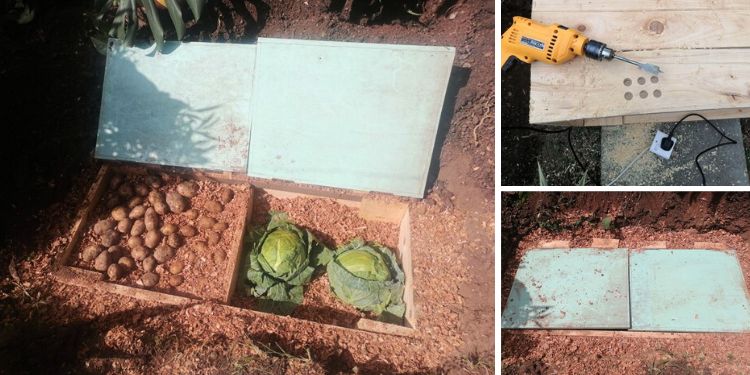











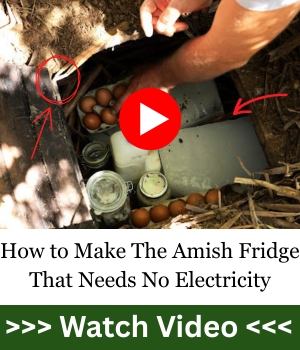

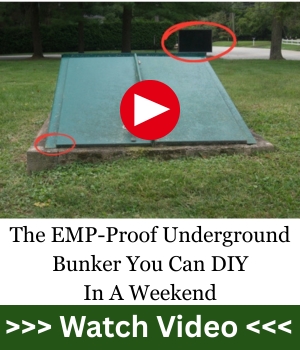






Love the idea! But please, if you live anywhere urban or suburban, call diggers hotline first-there are so many utilities in the ground, and digging could be problematic. Second, an upside-down soda or bread crate is a gteat way to elevate your vegetables from the ground and keep spoiling to a minimum.
your produce will last even better if you use peat moss instead of sawdust to pack them in. also seems to keep damp better. I’ve kept potatoes for 8 months and they look like you just dug them
This concerns the Web Site itself! When trying to read an article, if you try to go back (UP) on the page a bunch of graphics drop down and cover the article – until you start to cursor down again. This is EXTREMELY IRRITATING, and not necessary. Please have the Web Master take a look at this process and try to eliminate that irritating drop down process.
Jesse,
Switch to “Brave” for a browser. It blocks all that stuff, even commercials on YT videos.
Jesse –
View the website in “landscape” ande you shouldn’t have that issue.
I use Firefox (on Ubuntu Linux OS) and experience no problems at on, Firefox is available for Microsoft as well.
Glenn Meder – privacyactionplan.com
Has a newsletter on internet privacy. He’s information on search engines and web browsers are up to date. Ubuntu is better than Gate’s microsoft window’s bloatware os.
I am just thinking outload here but what would you think of using an old dead chest freezer instead of building the box? You would still want it mostly underground and all the other considerations still apply but I think I could get an old freezer for less money than the wood to build the box. Lumber isn’t cheap. One would have to secure the lid so a child couldn’t get in (I think there is even a law to that effect).
Domeliving, their are videos on refrigerator root cellars that will show how.
Paul, thanks for the heads up. I am checking them out.
You would still need to dig below the frost line. If you’re in an area where the frost line was deep and there was little snow, your veggies would still freeze.
Termite-treated boards? I’ve seen treated 2x4s and other foundation size timber sold treated, but those looked like pine boards the photos.
Drilled holes in the sides top and bottom and buried it under ground? How’s that air flow gonna work? What was the “but you’ll need to place holes at the top…” but what? The doors are obviously not air tight…
Too many issues with this “plan”
Treated boards may leach the chemicals into the food. May need to use a protective liner. That might not help as the barrier can break down and leak.
Just need to use good old American ingenuity problem solving.
This is great project for some regions. If living in rock and clay soils digging takes for ever. Alternative is to build the wood bin and build a mound around it. Like the construction of a raised bed is done.
I’m in that same rock/clay situation. Plus 100°++ in the summer. Wondering how far down I’d have to go before finding that minimum of 50° or less! Backhoe to 6’?
Try using a thermometer cover from direct sun. A good estimate 2′ to 4′. Most people in rocky, clay soils won’t get much more than 3′ if lucky.
Unless we use gas powered tools to dig further. Then that defeats the purpose if we need to it secret. Then neighbors will know something is up.
If not go for it.
The rocky clay soil is why I have raised vegetable beds. Thank God, for those who have better loam soils to work with.
Root cellar in a box is a good idea. I never thought of it this way. Thanks for sharing.
Hey. Assignment Online has been an absolute game-changer for me in my academic journey. Their dedicated team of experts consistently delivers top-notch assistance, ensuring that my assignments https://assignmentmaster.com/ are not just completed on time but also of exceptional quality. Their service is a lifesaver, especially when faced with tight deadlines and complex tasks. The ease of communication and the depth of expertise in their subject matter specialists make it a truly reliable platform for academic support. Assignment Help Online has my trust and gratitude for helping me excel in my studies!
I would like to take advantage of the special book offer that is now available for $39.00; however, I am unable to access the books or print them off to read at a later time. In my case, digital copies are not going to work.